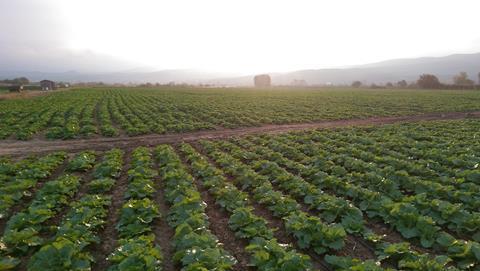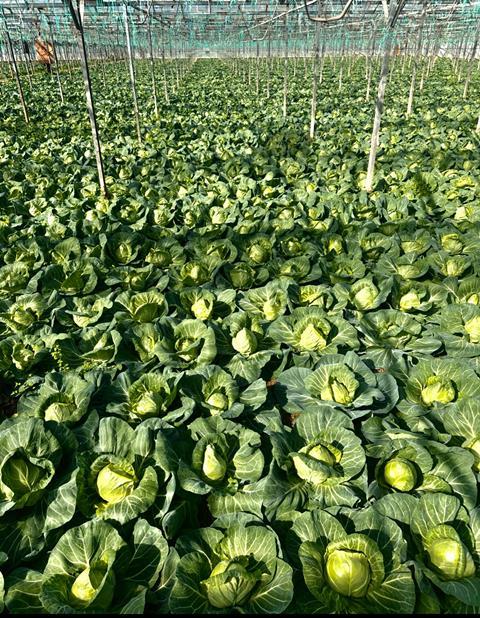North Macedonia has seen its share of the European cabbage market increase through early harvests and competitive production

North Macedonia is quietly but steadily building a solid position in the European fresh cabbage market. This country has a rich tradition of vegetable production thanks to its favourable Mediterranean climate and fertile soils in the valleys of the Vardar and Strumica rivers. The main products grown are peppers, tomatoes, cucumbers, cabbages and onions, with the regions of Strumica, Gevgelija and Tikvešija standing out as the most important centres.
Part of the production is intended for fresh consumption and export, while the other half is processed into traditional products such as ajvar and preserves, as well as modern industrial products for export to the EU.
Market diversification key
Cabbage exports from Macedonia have intensified significantly over the past decade according to ITC Trade Map data. Export volumes fluctuate between 45,000 and 70,000 tonnes. However, the real shift has occurred in market diversification and increasing export value from €13mn in 2014 to €30mn in 2024.
There is a noticeable shift from exports to traditional partners (Serbia, Bosnia and Herzegovina and Bulgaria) to markets in northern and eastern Europe. Comparing 2014 and 2024, Macedonian cabbage exports to Poland have increased from 5,000 tonnes to over 16,000 tonnes, to Ukraine from 2,500 tonnes to over 14,000 tonnes, to Lithuania from 1,100 to 2,700 tonnes, and to Sweden from 500 tonnes to 1,700 tonnes.
Simultaneously, exports of the same product to Serbia fell by 40 per cent, to Bulgaria by 62 per cent, and to Bosnia and Herzegovina by 64 per cent. Simply put, these alternative yet still nearby markets express greater interest and demand for quality fresh cabbage, which North Macedonia can offer from March to June each year. Consequently, average prices in these markets are somewhat more favourable. Whilst Macedonian exporters achieved an average export price for cabbage of €0.34/kg in Balkan markets in 2024, in Poland, Ukraine or the Baltic countries they could count on an average of €0.47/kg, and over €0.70/kg in Scandinavian markets.

“The key advantage of North Macedonia in cabbage production and export is the favourable climate and soil for this type of production,” says Sašo Risteski, director of the Macedonian Association of Fruit and Vegetable Processors. “Additionally, it is estimated that over 2,000 family farms are dedicated to commercial production of this vegetable, but an even larger number of smaller, non-commercial farmers are involved in production.
According to FAOSTAT data, North Macedonia produces over 135,000 tonnes of cabbage on approximately 4,800ha, just less than half going for export. “Exports are characterised by seasonality, with peak exports from March to May each year,” explains Risteski. “The remainder is placed on the domestic market, whilst a good portion is processed as sauerkraut and pickles. Exports are concentrated around several larger companies such as Badzo and Hortena, which are themselves significant producers, as well as exclusively trading firms such as Safir.”
Supporting the sector
The Macedonian ministry of agriculture regularly provides subsidies for vegetable production, similar to the level of support offered by other countries in the region, but no export incentives are provided by the state.
“Macedonian cabbage producers have largely built their solid export position themselves,” says Risteski, “through hard work and good marketing. Recently, key firms from this sector have formed the Makfresh association. Companies from the agricultural and food sector receive support for marketing and promotion from the Macedonian ministry of agriculture. This primarily refers to participation at renowned European trade fairs, such as Fruit Logistica and Alimentaria. The absence of certain special subsidies speaks to the fact that horticulture in Macedonia is a sustainable and competitive sector.”
Certainly, EU support funds (IPARD) are significant for domestic companies ready to invest. However, expansion into new, better-paying markets is not without challenges. More and more buyers require GlobalGAP certification, GRASP compliance and comprehensive pesticide residue testing.
“The Macedonian vegetable sector benefits above all from its strong base of family labour – thousands of small farms with deep experience, know-how and a long-standing tradition in vegetable cultivation,” says Risteski. “Because of this, introducing certified production practices should be straightforward, requiring only solid organisation and a modest initial investment. With the above in mind, better connectivity with European retailers and mainstream distribution channels is the future that awaits Macedonian vegetable growers.”



